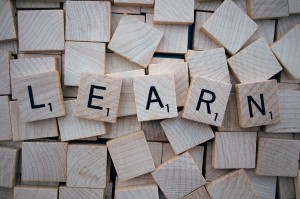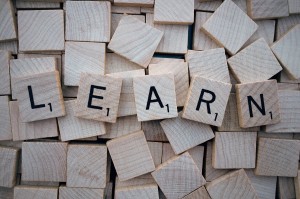
 Become a PowerPoint Guru by Dave Tracy
Become a PowerPoint Guru by Dave Tracy
Learn the methodologies, frameworks, and tricks used by Management Consultants to create executive presentations in the business world.

 Become a PowerPoint Guru by Dave Tracy
Become a PowerPoint Guru by Dave Tracy
 Transformation of an organization into a Next-generation Learning Organization (NLO) is a challenging endeavor. The main hurdles include convoluted hierarchies, bureaucratic red tape, delayed decision making, and complicated organizational systems and processes.
Transformation of an organization into a Next-generation Learning Organization (NLO) is a challenging endeavor. The main hurdles include convoluted hierarchies, bureaucratic red tape, delayed decision making, and complicated organizational systems and processes.
To develop a learning organization, leadership needs to trim down bureaucracy and complexities. They should make the best use of technology to gather holistic real-time data, deploy Artificial Intelligence at scale, and develop data-driven decision-making systems.
Five Core Pillars of Learning are essential for the creation of a Next-generation Learning Organization, including:
Let’s take a deep dive into the first 3 Core Pillars.
The first pillar is Digital Transformation. Next-generation Learning Organizations (NLOs) are characterized by their speed of learning and their adeptness to take action based on new insights. They use emerging technologies to automate as well as “autonomize” their businesses, without relying too much on human intervention and decision-making.
By autonomizing, the NLOs enable machines to learn, take action, and evolve on their own based on continuous feedback. They create integrated learning loops where information flows automatically from digital platforms into AI algorithms where it is mined in run-time to gather new insights. The insights are passed to action systems for necessary action that create more data, which is again mined by AI, and the cycle continues, facilitating learning at fast pace.
Next-generation Learning Organizations (NLOs) schedule time for their people to have unstructured reflection on their work. While most organizations fear disruption of human work in future by AI and machines, NLOs assign unique roles to their people based on human cognition strengths—e.g., understanding relationships, drawing causal judgment, counterfactual thinking, and creativity. These organizations are aware of AI’s advantage—in analyzing correlations in complex data promptly—as well as its shortcomings in terms of reasoning abilities and interpretation of social / economic trends. NLOs make design the center of their attention and utilize human creativity and imagination to generate new ideas and produce novel products. They assign roles accordingly, inspire imagination in people by exposing them to unfamiliar information, and inculcate dynamic collaboration.
NLOs foster innovative ways to promote collaboration between people and machines. They recognize that this helps them in better utilization of resources, maximize synergies, and learn dynamically.
To create effective collaboration between people and machines, NLOs develop robust human-machine interfaces. The existing AI systems lack the ability to decipher everything, which is an area where humans excel. NLOs supplement these shortcomings by setting up human-machine interfaces, where humans assist the AI by corroborating its actions and suggesting sound recommendations. These learning organizations bifurcate responsibilities based on the risks involved, assign humans and machines appropriately against each job, and select a suitable level of generalization and sophistication between humans and machines.
Interested in learning more about the Core Pillars of Learning? You can download an editable PowerPoint on Next-generation Learning Organization: Core Pillars here on the Flevy documents marketplace.
You can download this and hundreds of other consulting frameworks and consulting training guides from the FlevyPro library.
 Unsuccessful software applications cost organizations significant efforts and resources. The reasons for these failed ventures are often attributed to technology issues. However, the real issue is flaws in business processes—the enterprise application deployment environment and the ecosystem which the application targets.
Unsuccessful software applications cost organizations significant efforts and resources. The reasons for these failed ventures are often attributed to technology issues. However, the real issue is flaws in business processes—the enterprise application deployment environment and the ecosystem which the application targets.
This calls for ensuring the organizational readiness before initiating technology deployment. It is for this reason the Business Process Maturity Model (BPMM) originated. BPMM helps achieve uniform standards, identify weaknesses in workflows, and create standardized tailored processes that simplify the requirements for enterprise applications.
BPMM’s roots can be traced back to the Process Maturity Framework (PMF) created by Watts Humphrey and his colleagues at IBM in the late 1980s. Process Maturity Framework explores the ways to introduce quality practices in software development. Humphrey and his colleagues introduced incremental stages to adopting best practices in software organization. The PMF served as the groundwork for the development of the Capability Maturity Model (CMM) for software in 1991. CMM then became the foremost standard for appraising the capability of software development organizations.
BPMM ensures the success of enterprise systems by providing proven methods for system requirements validity; accuracy of use cases, and effectiveness of applications; simplification of requirements for enterprise applications; and providing a reliable standard for appraising the maturity of business process workflows.
BPMM considers processes as workflows across organizational boundaries. The key guiding principles governing BPMM are:
BPMM has the following 4 primary utilities.
Evaluating the BPMM conformance is about ensuring that the implemented system meets the needs of the client. Verification of conformance necessitates an effective appraisal technique to gather multiple forms of evidence to evaluate the performance of the practices contained in the BPMM.
The BPMM conformance appraisal should be headed by an authorized Lead Appraiser—external to the organization, trained in BPMM as well as appraisal methods. The team under the lead appraiser should include some members internally from the organization. The BPMM conformance appraisal team gathers and analyzes evidence regarding the implementation of BPMM practices, judges their strengths and weaknesses, and gauges their effectiveness in meeting the goals of the process areas at respective maturity levels.
The following evidence is utilized during BPMM conformance appraisals:
BPMM Conformance Appraisals help assure the implementation of practices at a level that achieve the intent and goals of the practices and their process areas. BPMM conformance appraisals are of 4 distinct types:
BPMM encompasses 5 maturity levels that signify the transformation of an organization on the basis of improvements in its processes and capabilities. BPMM Maturity levels 2, 3, 4, and 5 each contain 2 or more process areas, whereas the Maturity level 1 does not contain any process areas. The 5 successive levels of BPMM are:
The focus of the BPMM level 1 is on achieving economy of scale, automation, and productivity growth by encouraging people to overcome challenges and complete their tasks.
The 2nd maturity level aims at developing repeatable practices, minimizing rework, and satisfying commitments — by managing work units and controlling workforce commitments.
The focus of the 3rd maturity level of BPMM is to accomplish standardization in terms of business processes, measures, and training for product and service offerings.
The 4th maturity level aims at achieving stable processes, knowledge management, reusable practices, and predictable results. Organizations accomplish these results through standardization and managing processes and results quantitatively.
The focus of the organizations operating at the highest maturity level of BPMM is on implementing continuous improvements, developing efficient processes, and inculcating innovation.
Interested in learning more about the process areas and practices at various maturity levels of the Business Process Maturity Model? You can download an editable PowerPoint on Business Process Maturity Model here on the Flevy documents marketplace.
You can download this and hundreds of other consulting frameworks and consulting training guides from the FlevyPro library.

Business environment has transformed drastically from what it was a century ago. It has become immensely challenging due to competition, disruptive technologies, laws, and globalization. These challenges warrant better performance to address customer needs and to survive—and outpace—intense competition. Consequently, organizations have become complex.
The work that individuals perform in an organization has also shifted from manual labor and clerical jobs to knowledge-based experiential tasks. Traditional workforce was required to adhere to commands and stick to routines, whereas today’s workforce needs to be more empowered, innovative, able to adapt to varying circumstances, and render sound judgment.
Adapting with the constantly changing business environment is essential for organizations aspiring to succeed in today’s competitive markets. In order to stay competitive, more and more organizations across the globe are undertaking Business Transformation programs to reorganize their businesses. However, a large percentage of such programs fail to achieve the desired outcomes.
For the Organizational Design to be successful, leaders need to be mindful of the revolutionized work settings and business environment of this age. One of the major factors attributed to these failure rates is utilizing traditional approaches to reorganization, which are proving ineffective in this digital age. These traditional approaches appreciate “level of control” and power, and underestimate the significance of employee autonomy and innovation.
Today’s Knowledge Economy necessitates the employees to be more empowered to decide on their own than merely following commands. People act in ways that are best for their own interests. The new approach to reorganization—termed Smart Organizational Design—aligns the workforce’s best interests with the organizational mission rather than seeking control over the employees. The focus is on changing the environment (context) and mindsets of employees willingly and instilling team work and cooperation, thereby enhancing organizational performance considerably.
The Smart Organizational Design approach entails classifying the existing workforce behaviors, ascertaining the desired behaviors critical to improve performance, and providing environment (context) favorable to develop new behaviors. The approach encompasses 3 main steps:
Let’s dig deeper into the second step.
The next step involves the leadership to determine the “what” element of the Smart Organizational Design approach—i.e., definition of certain behaviors critical to achieve the transformation purpose. Determining the desired behaviors necessitates thinking through the following 4 critical Smart Organizational Design aspects. These 4 design aspects work in tandem to shift the environment (context) for the workforce and motivate them to embrace the new behaviors crucial for improved performance:
Interested in learning more about the other step of the Smart Organizational Design approach and the factors critical for its success? You can download an editable PowerPoint on Smart Organizational Design here on the Flevy documents marketplace.
You can download this and hundreds of other consulting frameworks and consulting training guides from the FlevyPro library.
 Inculcating productive workforce behaviors is of utmost significance in Business Transformation, successful Strategy Execution, and Performance Improvement. However, making people embrace productive behaviors involves a concerted effort across the organization.
Inculcating productive workforce behaviors is of utmost significance in Business Transformation, successful Strategy Execution, and Performance Improvement. However, making people embrace productive behaviors involves a concerted effort across the organization.
The realization of Transformation, Strategy, and Performance improvement goals can become a reality by developing a thorough understanding of the 4 components of Organizational Behavior. These components act as powerful levers in shaping the desired behaviors in the workforce:
These Organizational Design levers work effectively when combined and aligned. Let’s discuss the first 2 levers in detail now.
Organizational Structure represents the management reporting lines that create the organization’s spans of control, layers, and number of resources. Organizational Structure is a foundational driver to Organizational Design, which also has a strong positive bearing on promoting the behaviors critical to improve the overall performance of the enterprise. This is owing to the power that a position exerts on the subordinates based on factors that are important for individuals—e.g., work, compensation, and career ladder.
The Organizational Structure indicates an enterprise’s priorities. An organization is typically structured in accordance with its top most priority. For instance, functional organizational structure is adopted by enterprises having functional excellence as a priority. In present-day’s competitive markets, most organizations have to deal with several priorities at a given time, which could be conflicting. However, this does not mean adding new structures on top of existing ones, thereby increasing unnecessary complexity. Creating overly complex structures to manage multiple priorities results in red tape and delayed decisions. All roles are interdependent, necessitating cooperation. This means taking care of the needs of others—instead of just watching over personal priorities—and encouraging individual behaviors that boost the efficiency of groups to achieve collective objectives.
Roles and responsibilities deal with tasks allocated to each position and individual. Organizational Design depends heavily on redefining clearer and compelling roles and responsibilities—to avoid any duplication of efforts or creating adversaries among team members. In a collaborative culture where cooperation is the mainstay of an organization, individuals should not only be aware of what is required of them, but also appreciate the responsibilities of their team members, the authorities their roles exercise, the skills required, and the metrics to measure success.
A methodical way to outline roles and responsibilities effectively—while minimizing complexity—that encourages cooperation and empowerment is through the “Role Chartering” technique. The technique requires distinctly identifying all roles on the basis of 6 key factors:
Interested in learning more about these components to Organizational Behavior? You can download an editable PowerPoint on Organizational Behaviors here on the Flevy documents marketplace.
You can download this and hundreds of other consulting frameworks and consulting training guides from the FlevyPro library.
 The Value Chain concept, first described by Dr. Michael Porter in 1985, is a series of actions that a firm—in a specific industry—accomplishes to produce a valuable product or service for the market. The value chain notion visualizes the process view of an organization, perceiving a manufacturing or service organization as a system comprised of subsystems of inputs, transformation processes, and outputs.
The Value Chain concept, first described by Dr. Michael Porter in 1985, is a series of actions that a firm—in a specific industry—accomplishes to produce a valuable product or service for the market. The value chain notion visualizes the process view of an organization, perceiving a manufacturing or service organization as a system comprised of subsystems of inputs, transformation processes, and outputs.
Another way to define the Value Chain principle is, “transforming business inputs into outputs, thereby creating a value much better than the original cost of producing those outputs.” These inputs, processes, and outputs entail acquiring and utilizing resources—finances, workforce, materials, equipment, buildings, and land.
An industry Value Chain includes the suppliers that provide the inputs, creation of products by a firm, distribution value chains, till the products reach the customers. The way Value Chain activities are planned and executed determines the costs and profits.
Value chains consist of set of activities that products must undergo to add value to them. These activities can be classified into 2 groups:
Primary activities in Porter’s Value Chain are associated with the production, sale, upkeep, and support of a product or service offering, including:
The secondary activities and processes in Porter’s Value Chain support the primary activities. For instance:
The analysis of a Value Chain offers a number of benefits, including:
Businesses seeking competitive advantage often turn to Value Chain models to identify opportunities for cost savings and differentiation in the production cycle. The Value Chain Analysis (VCA) process encompasses the following 3 steps:
The first step in Value Chain Analysis necessitates identification of activities that are essential to undertake in order to deliver product or service offerings. Key activities in this stage include:
The second phase of the Value Chain Analysis necessitates identifying tasks required under each primary activity that create maximum value. This phase is characterized by:
Interested in learning more about the other phases of the Value Chain Analysis Approach? You can download an editable PowerPoint on Strategy Classics: Porter’s Value Chain here on the Flevy documents marketplace.
You can download this and hundreds of other consulting frameworks and consulting training guides from the FlevyPro library.
 Gordon Moore, Intel co-founder, observed that the number of transistors in a dense integrated circuit doubles about every two years. He projected that this rate of growth would continue for at least another decade.
Gordon Moore, Intel co-founder, observed that the number of transistors in a dense integrated circuit doubles about every two years. He projected that this rate of growth would continue for at least another decade.
His observation, termed the “Moore’s Law,” has correctly predicted the pace of innovation for several decades and guided strategic planning and research and development in the semiconductor industry. Moore’s law is based on observation and projection of historical trends.
In 2015, Gordon Moore foresaw that the rate of progress would reach saturation. In fact, semiconductor advancement has declined industry-wide since 2010, much lower than the pace predicted by Moore’s law. The doubling time and semi-conductor performance has changed, but it has not impacted the nature of the law much.
Although many people predict the demise of Moore’s law, exponential growth in computing power persists with the emergence of innovative technologies. Moore’s law is only part of the equation for effective Digital Transformation—there are other contributing factors including the role of leadership.
George Westerman—a senior lecturer at the MIT Sloan School of Management—proposes a new law, which states that, “Technology changes quickly, but organizations change much more slowly.” The law known as the “First Law of Digital Transformation” or “George’s Law” is a pretty straightforward observation, but is often ignored by the senior leadership. This is why Digital Transformation is considered more of a leadership—than technical—issue.
Just announcing an organization-wide Transformation program does not change the enterprise. According to George’s Law, successful Digital Transformation hinges on the abilities of senior leadership to effectively manage the so many contrasting mindsets of its workforce, identify and take care of the idiosyncrasies associated with these mindsets, interpret their desires, and focus attention on encouraging people to change.
Above all, the leadership should focus on converting Digital Transformation from a project to a critical capability. This can be done by shifting emphasis from making a limited investment to establishing a sustainable culture of Digital Innovation Factory that concentrates on 3 core elements:
Let’s now discuss the first 2 elements of the First Law of Digital Transformation.
Without a clear and compelling transformative vision, organizations cannot gather people to support the change agenda. People can be either change resisters, bystanders, or change enablers. However, most people typically tend to like maintaining the status quo, ignore change, or choose to openly or covertly engage in a battle against it.
For the employees to embrace change, leadership needs to make them understand what’s in it for them during the transition and the future organizational state. This necessitates the leaders to develop and share a compelling vision to help the people understand the rationale for change, make people visualize the positive outcomes they can achieve through Transformation, and what they can do to enable change. A compelling vision even urges the people to recommend methods to turn the vision into reality.
Problems and shortcomings in the legacy platforms is an important area to focus on during Digital Transformation. The legacy technology infrastructure, outdated systems, unorganized processes, and messy data are the main reasons for organizational lethargy. These issues hinder the availability of a unified view of the customer, implementing data analytics, and add to significant costs in the way of executing Digital Transformation.
Successful Digital Innovation necessitates the organizations to invest in streamlining the legacy systems and setting up new technology platforms that are able to enable digital and link the legacy systems. Fixing legacy platforms engenders leaner and faster business processes and helps in maintaining a steady momentum of Innovation.
Interested in learning more about the First Law of Digital Transformation? You can download an editable PowerPoint on First Law of Digital Transformation here on the Flevy documents marketplace.
You can download this and hundreds of other consulting frameworks and consulting training guides from the FlevyPro library.

Organizations need to persistently improve the way they do business to stay ahead of the curve. New ideas trigger organizational improvement and build the foundation of a Learning Organization.
Scholars have defined a Learning Organization in many different ways. Some suggest it as an organization skilled at creating, acquiring, and transferring knowledge, and at modifying its behavior to reflect new knowledge and insights. Marlene Fiol and Marjorie A. Lyles describe organizational learning as “the process of improving actions through better knowledge and understanding.” Barbara Levitt and James G. March define organizations as “Learning Organizations when they encode inferences from history into routines that guide behavior. Chris Argyris categorizes organizational learning as “a process of detecting and correcting error.” According to Peter Senge, “a Learning Organization is a group of people working together collectively to enhance their capacities to create results they care about.”
Being a Learning Organization offers several advantages. A perpetual influx of insights and new experience keeps the organization dynamic and ready for transformation; assists in better management of investments, improves efficiency; and helps in developing cost leadership and differentiation strategies. Learning Organizations tend to be more innovative by encouraging people to learn, develop, and by generating a more innovative environment. Shared learning builds the corporate image of the organization and increases the pace of change within the organization. Learning Organizations provide their people the ability to think insightfully about complex problems, take coordinated action, improve decision making, and instill a sense of community in them.
Despite efforts to improve continuously and creating new knowledge, organizations cannot simply become Learning Organizations. They employ various approaches but what they actually need is to become proficient in translating new knowledge into new ways of doing things, and actively managing the learning process so that it gets ingrained into the organizational culture.
Becoming a Learning Organization necessitates mastering 5 key activities. These 5 activities form the building blocks of a Learning Organization and should be integrated into the organizational core to transform your company into a Learning Organization.
Applying these practices to some degree or in isolated cases isn’t enough. To ensure continued success, these practices should be complemented by distinct mindsets, support systems, and processes.
Let’s now discuss the first 3 building blocks in detail.
Systematic problem solving is based on scientific methods for diagnosing problems, e.g., the Plan, Do, Check, Act (PDCA) cycle or “hypothesis-generating, hypothesis-testing.” The technique employs fact-based management, relying on concrete data instead of assumptions for making decisions and utilizes statistical tools—such as Pareto charts, histograms, correlation, and cause and effect diagrams—to consolidate data and draw conclusions.
For a real Learning Organization, people need to become more disciplined, pay more attention to detail, assess underlying causes, and analyze data before reaching decisions.
Experimentation involves systematic exploration and testing of new knowledge. Experimentation has 2 fundamental configurations; both forms transfer knowledge and yield new insights, capabilities, tools, techniques, and processes:
Ongoing programs entails a chain of small experiments aimed at yielding incremental gains in knowledge. These programs maintain a steady flow of new ideas by sending workforce on sabbaticals at different places to learn new work practices and tools from industry and academia, and applying that knowledge to their daily routines. Such programs foster risk taking and a feeling of “benefits of experimentation far outweigh the costs.”
Demonstration projects are one of a kind, large-scale initiatives that include holistic system-wide transformation targeted at a single site. These projects are executed with a goal of developing new organizational capabilities using a “clean slate” approach.
Self-managing, multi-departmental teams; high level of employee autonomy; considerable “learning by doing;” course corrections; implicit policy guidelines, precedents, and decision rules are the key characteristics of demonstration projects.
Learning Organizations gain valuable knowledge from their past experiences, by doing an exhaustive and systematic appraisal of past successes and failures. However, not too many managers pay attention to past experiences or reflect on those, eventually losing valuable insights. To inculcate a culture of learning, lessons learned should be recorded and made readily accessible to all employees.
A handful of companies have laid out processes for their managers to contemplate on their past actions and incorporate those in their learning. At the core of this approach lies the belief that distinguishes productive failure from unproductive success. Productive failure delivers knowledge and understanding whereas unproductive success goes unnoticed where nobody knows what went well and why. Learning from experience approach isn’t that expensive—case studies and project reviews can be compiled with little cost.
Interested in learning more about the building blocks of a Learning Organization? You can download an editable PowerPoint on Learning Organization: 5 Building Blocks here on the Flevy documents marketplace.
You can download this and hundreds of other consulting frameworks and consulting training guides from the FlevyPro library.
 A large majority of organizations rarely focus on gathering and utilizing customer-centric knowledge. So much so that they even introduce a product without having vital insights on the customer and their unmet needs, and they are often clueless about them. Consequently, many product development initiatives fall flat as managers struggle to filter and evaluate ideas.
A large majority of organizations rarely focus on gathering and utilizing customer-centric knowledge. So much so that they even introduce a product without having vital insights on the customer and their unmet needs, and they are often clueless about them. Consequently, many product development initiatives fall flat as managers struggle to filter and evaluate ideas.
Most organizations, today, are developing initiatives around Customer Experience Strategy and Customer Journey Mapping. Customer-centric Organizations are deeply focused towards value creation for their customers. They understand the unique customer insights needed to make customer-centric decisions, are able to gather those customer insights, and are aware of the way to utilize the insights in creating value for their customers. By using customer insights, Customer-centric Organizations drive their product innovation success rate significantly higher than the industry average.
In order to develop this capability, organizations need to first utilize a customer-centric research process to gather the customer insights required to drive value creation. This is accomplished when:
Building a Customer-centric Culture of Innovation warrants a methodical approach. A potent approach to building such a culture of innovation encompasses 3 key phases:
The first phase commences by organizing an intensive workshop for each cross-functional product team. It is typically a day-long session where the teams engage in a unique customer journey. They employ a “jobs-to-be-done” lens to analyze their market and identify valuable, qualitative customer insights needed to drive customer-centric decision making. The qualitative customer insights developed during the first phase serve as an indispensable, long-term guide in the journey to a customer-centric mindset.
During phase I, each product team is trained on customer-centric philosophy in a workshop settings. The workshop participants participate in qualitative research discussions designed to obtain critical customer information and fresh insights. Upon completion of the initial phase, the product team is able to develop a shared innovation vocabulary and gather customer insights to make customer-centric marketing and product development decisions.
Interested in learning about the third phase of the approach to Customer-centric Culture of Innovation? You can download an editable PowerPoint on Customer-centric Culture of Innovation here on the Flevy documents marketplace.
You can download this and hundreds of other consulting frameworks and consulting training guides from the FlevyPro library.
 In this era of rapid change only organizations that are evolving and continuously learning can flourish. Successful organizations discover how to tap their people’s commitment and capacity to learn at all levels.
In this era of rapid change only organizations that are evolving and continuously learning can flourish. Successful organizations discover how to tap their people’s commitment and capacity to learn at all levels.
A Learning Organization is a place where people continually expand their capacity to create the results they truly desire, where new ideas and thinking are nurtured, and where people are continually learning to see the whole together. A Learning Organization is established on the principles of innovation, free flow of ideas, and a consistent focus on transforming the ways of doing business.
Learning Organizations adopt 5 distinct practices to succeed, which form the “building blocks” of such organizations:
Five key characteristics distinguish a Learning Organization from the rest. These attributes serve as the guiding principles and practices that these organizations study and integrate into their DNA. A blend of these core characteristics helps organizations adopt a more interconnected way of thinking:
By adopting and mastering these core characteristics organizations become communities that employees can commit to. Let’s, now, discuss the first 3 characteristics in detail.
Systems thinking allows people to study businesses as bounded objects. Learning Organizations possess information systems to assess the performance of the organization and its components as a whole. Systems thinking states that all the characteristics must be present together in an organization for it to be a Learning Organization. However, some experts consider that the characteristics of a Learning Organization are gradually acquired, rather than developed simultaneously.
Personal mastery is an individual’s commitment to learning. It is about becoming more productive by applying skills to work in the most constructive manner. It involves clarification of focus, vision, and to interpret reality objectively. Training, development, and continuous self-improvement are the sources of individual learning.
Mental models include assumptions and generalizations retained by individuals and organizations, which go undetected, as mental models limit peoples’ observations. Learning Organizations need to identify and challenge these models. For a learning environment it is important to replace confrontational attitudes with an open culture that promotes inquiry and trust, introduce mechanisms for uncovering and assessing organizational theories of action, and discard any unwanted values.
Productivity and competitiveness relies on knowledge generation and processing. Therefore, organizations not only have to invest in new machinery and systems to improve production, but also focus on knowledge generation and learning of their people. Learning Organizations require a new view of leadership. Leaders in Learning Organizations create workplaces that help people keep building their capabilities to understand complexity, clarify vision, and improve shared mental models.
Peter Senge describes the 3 key qualities of leaders to be critical in leading the Learning Organization:
The key roles of a leader as a designer in Learning Organizations is designing the policies, strategies, and systems. The designer also outlines the governing ideas — the purpose, vision, and core values — for the people. They plan and develop the learning processes whereby people throughout the organization can deal productively with the critical issues they face, and cultivate personal mastery of the team members in the desired learning disciplines.
According to Peter Senge, the notion of management in this modern age should be replaced by “stewardship” — whereby control and consistency should be swapped with partnership and choice. The leader as a steward tells ‘purpose stories’ about their organization and relate those stories. They explain the reasons of the tasks that are required to be performed, the need for the organization to evolve, and the purpose of evolution. They learn to listen to other people, involve them, and develop vision — both individual and shared.
Interested in learning more about the key attributes of leaders and core characteristics of a Learning Organization? You can download an editable PowerPoint on Learning Organization Primer here on the Flevy documents marketplace.
You can download this and hundreds of other consulting frameworks and consulting training guides from the FlevyPro library.
 Most Transformation initiatives fail to achieve their anticipated objectives.
Most Transformation initiatives fail to achieve their anticipated objectives.
Change Management is all about engaging and rallying people — at all levels in the organization — to make the transition and sustain that change. It is critical to ensure that the entire workforce is eager and ready to embrace the required new behaviors. More often than not, the technical side of a change initiative is well planned, but it’s the implementation part that fails — particularly, changing the mindsets and behaviors of the entire workforce to enable change to stick.
Managing change is not an occasional affair; it is an iterative process that works on motivating human behavior to accept and adjust to a desired state of mind. The process is naturally evolving as it adapts in accordance with the feedback from the people.
Change Management demands a thorough yet organized approach to enable the “people side” of change to work — essential for accommodating and sustaining Business Transformations. This entails assisting people incorporate new mindsets, processes, policies, practices, and behaviors.
A methodical approach to make the entire workforce accept and support change constitutes 8 critical levers:
Now, let’s discuss the first 4 levers in detail.
The first step entails outlining the rationale, scope, and results of the change initiative for the enterprise, key departments, and roles. There is a need to define critical elements, including the requirements from the initiative, the execution planning, and the adjustments needed to encourage people to work better.
The project sponsors need to clearly outline the essence of the proposed Transformation initiative, to realistically embed Change Management into the design of the program, and develop effective Change Management plans. An initial baseline of the expected effect of the program on people should be performed. The baseline also helps analyze the impact of the change program — in terms of skills inventory, head-count indications, adjustments in accountabilities and relationships, shifts in incentives and pay structures, and future learning needs.
Once the change and its impact has been delineated, the next thing to do is to create a shared understanding of the rationale for Transformation across the organization. To create a shared need for the Transformation endeavor, the change sponsor needs to build awareness of the necessity for change amongst the senior team, key stakeholders, and the entire organization; demonstrate to the people the benefits of change; and set up a feedback mechanism across the organization. The alignment afforded by developing a shared need for change helps build a strong footing for Transformation.
An essential element of implementing transformation entails delineating a clear vision that outlines critical actions and the anticipated outcomes. It helps in encouraging and involving the workforce in the Transformation initiative, giving them a sense of purpose by becoming a part of something bigger. The vision of the organization after Transformation should be coherent with the company values and mission.
This lever entails developing change leadership and implementation skills needed to drive and enable sustainable change. Engagement and commitment of senior leaders is essential for leading change. They are responsible for planning their and the entire workforce’s actions, demonstrating or role modeling the new mindsets and actions, designating program sponsors — e.g., business unit leaders who are enthusiastic about the Transformation initiative and also act as change agents — motivating others to support transformation, and setting up a road map for the change leaders to steer the organization to achieve the anticipated performance milestones.
Interested in learning more about these levers to Change Management? You can download an editable PowerPoint on 8 Levers to Change Management here on the Flevy documents marketplace.
You can download this and hundreds of other consulting frameworks and consulting training guides from the FlevyPro library.
Error: Twitter did not respond. Please wait a few minutes and refresh this page.